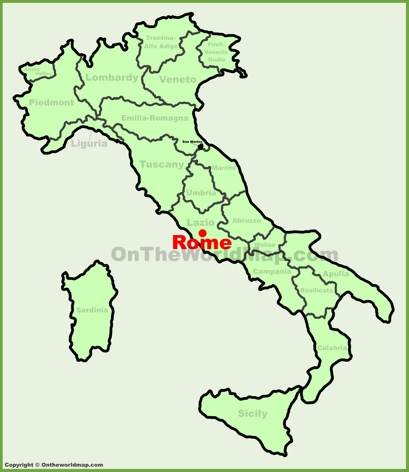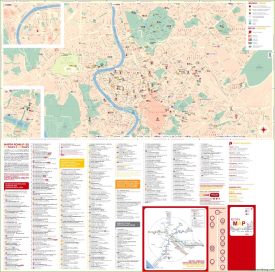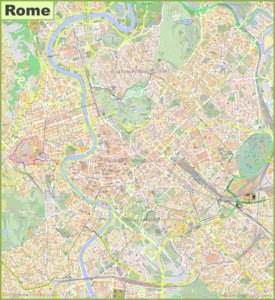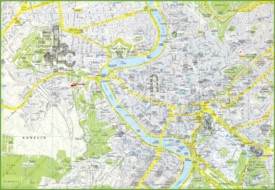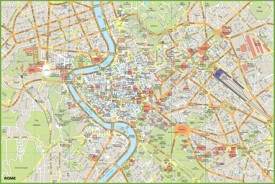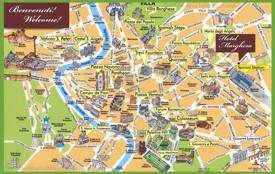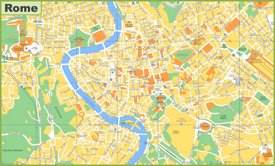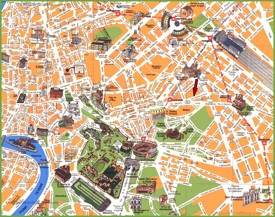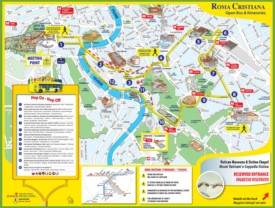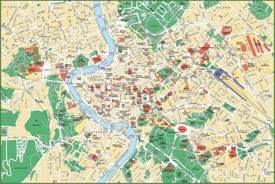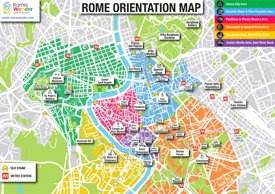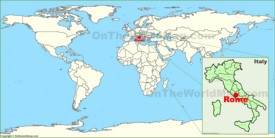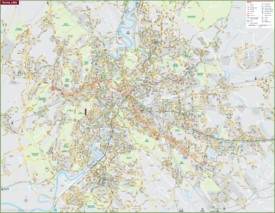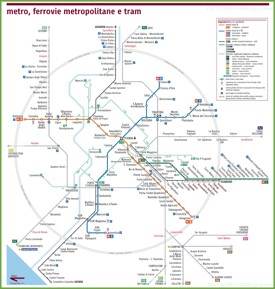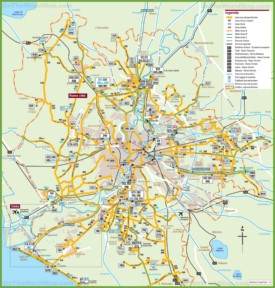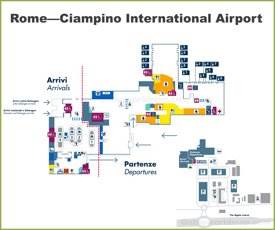Rome Map
Description:
This map shows streets, theaters, museums, palaces, fountains, archaeological areas, points of interest, public toilets, points of interest, tourist attractions, tourist information centers, and sightseeings in Rome.
Author: Roma - Sito turistico ufficiale www.turismoroma.it
You may download, print or use the above map for educational, personal and non-commercial purposes. Attribution is required. For any website, blog, scientific research or e-book, you must place a hyperlink (to this page) with an attribution next to the image used.
Online Map of Rome
Detailed Maps of Rome
Transportation Maps of Rome
Maps of Rome Airports
About Rome
Rome is the capital and largest city of Italy. It is the administrative center of the Lazio region and the Metropolitan City of Rome Capital, equated to a province. It is located on the Tiber River. Part of the territory of Rome belongs to the state of Vatican City. Founded in 753 BC Rome is one of the oldest cities in Europe, the capital of ancient civilization. Back in antiquity, Rome was called the “Eternal City”. Rome is also called “The City on Seven Hills” (Aventine, Caelian, Capitoline, Esquiline, Palatine, Quirinal, and Viminal). With 2,752,114[1] residents in 1,285 square kilometers (496.1 sq mi), Rome is the country's most populated comune and the third most populous city in the European Union by population.
Main sights and interesting places in Rome:
Arch of Constantine: This triumphal arch is located near the Colosseum and was erected in AD 315 to commemorate Constantine I's victory at the Battle of Milvian Bridge. It is the largest Roman triumphal arch and features reliefs and decorations from earlier monuments.

Capitoline Museums: Situated on the Capitoline Hill, these are among the oldest public museums in the world. They house a vast collection of art and archaeological artifacts, including the iconic bronze statue of the She-Wolf with Romulus and Remus.
Palazzo Senatorio: Located on the Capitoline Hill, this Renaissance palace serves as the seat of the Roman city council. It was designed by Michelangelo and is part of the Capitoline Museums complex.

Cordonata Capitolina: A monumental staircase designed by Michelangelo, leading from the Piazza del Campidoglio to the top of the Capitoline Hill. It is flanked by statues of Castor and Pollux.

Castel Sant'Angelo: Originally built as a mausoleum for Emperor Hadrian, this cylindrical building later served as a fortress and papal residence. It is connected to Vatican City by the Passetto di Borgo.

Ponte Sant'Angelo: Also known as the Bridge of Angels, this Roman bridge spans the Tiber River and leads to Castel Sant'Angelo. It is adorned with ten statues of angels designed by Bernini.

Circus Maximus: An ancient Roman chariot-racing stadium and mass entertainment venue located in the valley between the Aventine and Palatine Hills. It was the largest stadium in ancient Rome.

Colosseum: An iconic symbol of ancient Rome, this large amphitheater was used for gladiatorial contests and public spectacles. It is one of the greatest works of Roman architecture and engineering.





Palatine: One of the seven hills of Rome, it is considered the birthplace of the city. The hill is home to ancient ruins, including the Imperial Palaces, and offers views of the Roman Forum.


Pantheon: A former Roman temple, now a church, known for its large dome and oculus. It is one of the best-preserved ancient Roman buildings and has been in continuous use throughout its history.



Spanish Steps: A monumental stairway of 135 steps connecting the Piazza di Spagna with the Trinità dei Monti church. It is a popular gathering place and tourist attraction.

Piazza Navona: A public square built on the site of the Stadium of Domitian. It features Baroque architecture, including the Fountain of the Four Rivers by Bernini.


Roman Forum: The heart of ancient Rome, it was a center of political, social, and economic life. The forum contains ruins of important government buildings and temples.








Trevi Fountain: A famous Baroque fountain where visitors traditionally throw coins for good luck. It is one of the most popular tourist attractions in Rome.

Vatican: An independent city-state enclaved within Rome, it is the spiritual and administrative center of the Roman Catholic Church. It is home to the Pope and numerous religious and cultural sites.

St. Peter's Square: A large plaza located directly in front of St. Peter's Basilica in Vatican City. It is known for its grand colonnades and the central obelisk.

St. Peter's Basilica: One of the largest churches in the world, located in Vatican City. It is renowned for its Renaissance architecture, including Michelangelo's Pietà and the iconic dome.

Sistine Chapel: Located in Vatican City, it is renowned for Michelangelo's ceiling frescoes and The Last Judgment. It is the site of the papal conclave.
Victor Emmanuel II Monument: Also known as the Altare della Patria, this monument honors Victor Emmanuel II, the first king of a unified Italy. It is located in Piazza Venezia and features a massive equestrian statue.



Rome's economy is diverse, with significant contributions from tourism, services, technology, and research. It is a hub for banking and finance, as well as the headquarters for many national and international companies. The city also has a substantial public sector, being the administrative center of Italy. Rome is an important center for higher education and research, hosting several universities and institutions. The Sapienza University of Rome is one of the largest and oldest universities in Europe. The city also hosts international institutions such as the American University of Rome and John Cabot University.
Rome has a comprehensive transportation network that includes buses, trams, and a metro system with three lines: A, B, and C. The city is served by two international airports: Leonardo da Vinci–Fiumicino Airport and Ciampino Airport. Rome is also a major railway hub, with Termini Station being one of the busiest in Europe.
Brief history of Rome
Rome, often referred to as "The Eternal City," has a history that spans over 2,500 years. According to legend, it was founded in 753 BC by the twin brothers Romulus and Remus. Initially a small settlement on the Palatine Hill, Rome grew into a powerful city-state. During the Roman Kingdom (753–509 BC), it was ruled by a series of kings, but transitioned to a republic in 509 BC, characterized by a complex system of checks and balances.
The Roman Republic (509–27 BC) expanded through military conquests and alliances, dominating the Italian peninsula and beyond. Key events during this period include the Punic Wars against Carthage, which established Rome as a major Mediterranean power. In 27 BC, the republic transitioned into the Roman Empire, beginning with the reign of Augustus, the first emperor. The empire reached its territorial peak under Emperor Trajan in the 2nd century AD, stretching from Britain to the Middle East. This era, known as Pax Romana, was marked by relative peace and stability.
However, internal strife, economic troubles, and external pressures led to the decline of the Western Roman Empire, culminating in its fall in AD 476. The Eastern Roman Empire, known as the Byzantine Empire, continued to thrive for another millennium. Throughout the Middle Ages, Rome's influence waned, but it remained a significant religious center as the seat of the Papacy. During the Renaissance, Rome experienced a cultural revival, becoming a hub of art and architecture.
The Facts:
Region: Lazio.
Province: Metropolitan City of Rome.
Area: 496 sq mi (1285 sq km).
Population (2024): 2,752,114.[1]
Website: www.comune.roma.it
Page Navigation
References
1. Demografia in cifre. Italian National Institute of Statistics.Maps of Italy
Cities of Italy
Cities of Italy
Regions of Italy


